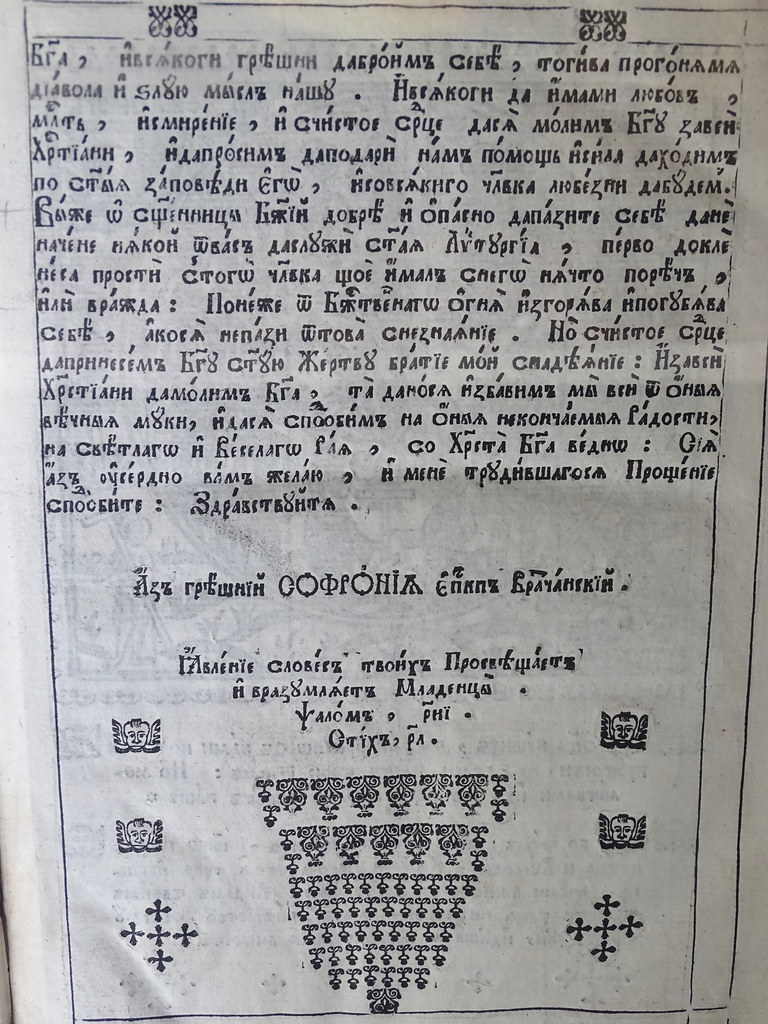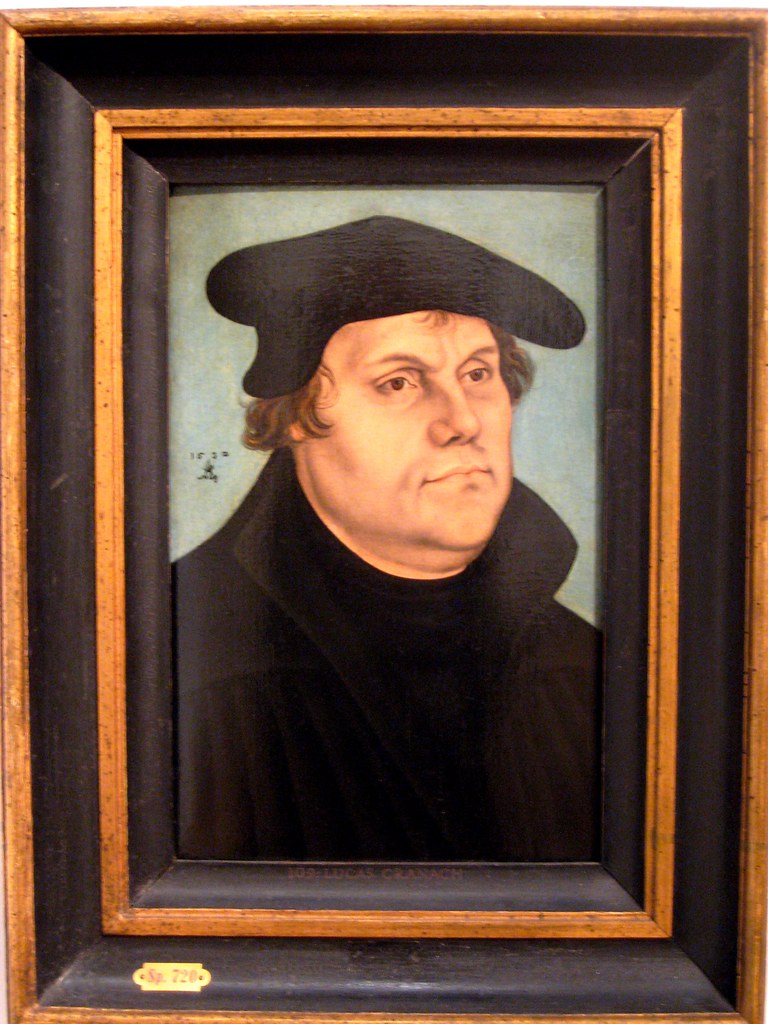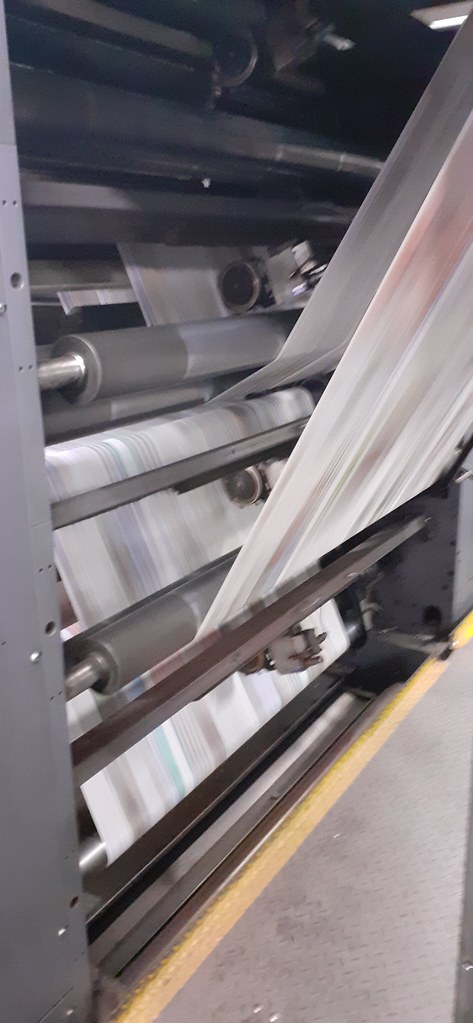The printing press was invented during the Holy Roman Empire by the German Johannes Gutenberg around 1440, based on existing screw presses. A printing press is a device for applying pressure to an inked surface resting upon a print medium, thereby transferring the ink.

image source: https://search.creativecommons.org/photos/f9921bef-146a-421c-98ec-786d2bda69b5 by dronepicr
Who Invented the Printing Press?
Johannes Gutenberg is usually referred to as the inventor of the printing press. Indeed, the German goldsmith contributed, in 15th-century, to the development of revolutionary technology that enabled the mass production of books and the rapid propagation of knowledge throughout Europe.

Image source: https://search.creativecommons.org/photos/e52d833c-d511-4280-b03c-6ff467b88987 by Ewald Judt
Gutenberg discovered that to speed up the printing process, he needed to split the standard wooden blocks down into single components: lower and upper-case letters and punctuation marks. He made these movable blocks of letters and symbols out of different metals, including lead, antimony, and tin. He also created his ink using linseed oil and soot.
But what set Gutenberg was his development of a press that mechanized the transfer of ink from movable type to paper. Adapting the screw mechanisms found in wine presses, papermaker presses, and linen presses, Gutenberg developed a press perfectly suited for printing. The first printing press allowed for an assembly line-style production process that was much more efficient than pressing paper to the ink by hand. For the first time in history, books could be mass-produced and at a fraction of the cost of conventional printing methods.
Why was the invention of printing press so important?
Image source: https://search.creativecommons.org/photos/2b548bfc-f244-48d9-ad53-fc3ed3f9f5df
In the centuries before print, books were handwritten by trained scribes. So, the books were so expensive to create and only available to the rich. Knowledge was strictly controlled by those who could afford or who had access to books. Knowledge was often controlled by the church, which had the resources to pay scribes and could decide that it was written. Once the books were easily available to the average person, literacy increased and the power of the church began to be decentralized.

image source: https://search.creativecommons.org/photos/2c8d6a24-8894-44e4-9037-58bf25b33350 by Adam Jones, Ph.D. – Global Photo Archive
The printing technique spreads rapidly. Fifty years after the Gutenberg Bibles, 2,500 presses were operating all over Europe. With so many printed books, information has been shared at an unprecedented rate. Maps, facts, and history could be recorded accurately and quickly, leading to an explosion of scientific knowledge, as scientists could gather their information to promote their understanding of the world.
In addition to books, newspapers and other periodicals began to be printed. This has created communities that could share common information and interests. The written word was able to advance new ideas, bring people together, and sometimes control the government’s power. The printing itself, with its interchangeable mobile parts, set the stage for many other tools and machines that could produce new products. Because of its discoveries in production and its ability to spread knowledge, the press has opened up the modern world.
What impact did the Invention of the Printing Press have on society and religion?
Johann Gutenberg’s invention of the printing press, around 1448, had a significant impact on the spread of ideas in Europe and beyond. Printing technology traveled quickly across Europe and, at a time of great religious change, played a key role in the success of the Protestant Reformation.
![A Noble Fragment being a leaf of the Gutenberg Bible [recto]](https://live.staticflickr.com/4005/4604991676_33dac47eaf_b.jpg)
Image source: https://search.creativecommons.org/photos/b918c165-3057-4b76-beea-7c946df419b3 by Boston Public Library
The printing press drastically lowered the expense of creating books and other printed materials. Before Gutenberg’s invention, the only way of making multiple book copies was to reproduce the text by hand. The materials involved were also expensive: Monks wrote on treated skins, known as vellum. Printing onto paper made copying cheaper and faster.
The first books Gutenberg printed were copies of the Bible. The Gutenberg Bibles were immensely successful, and all 200 copies were sold even before the full printing was completed. The newly printed Gutenberg version became the standard version and the basis for future Bible texts.
Gutenberg’s printing press “meant more access to information, more dissent, more informed discussion, and more widespread criticism of authorities,” comments the British Library. The printing press represented a key part toward popularizing ideas correlated with the new Protestant faith throughout the European Reformation, enabling the press to form and lead a mass movement.

image source: https://search.creativecommons.org/photos/0d8d1b05-f556-4c5e-b8c7-348a980d7f81 by moria
Protestant intellectuals used the printing press to diffuse their ideas across Europe, principally through pamphlets. In the first years of the Reformation, German-language printing presses created numerous pamphlets that expressed the ideas of Reformation leader Martin Luther, outnumbering Catholic authors and producing 20 percent of all pamphlets published between 1500 and 1530. The invention of the printing press decreased power over written materials by the Catholic Church and made it hard for the church to inhibit the expanse of what it regarded as heretical ideas.
What was the benefit of printing press on education?
The printing press has had enormous implications for education and the state of the world. Hundreds of thousands of copies of one scholar’s work could be made and dispersed after the invention of the printing press. Ideas from the Italian Renaissance spread west and north and influenced artists, scientists, and philosophers throughout Europe and beyond.

Image source: https://search.creativecommons.org/photos/ceae2d29-d0e9-4c0f-8884-1ec42b363fd1 by dronepicr
Before the invention of the printing press, ideas and experiences often died with the person who possessed them, so each generation had to start from scratch. The invention of the printing press determined that scholars could read work created by other scholars and grow on this knowledge. The printing press hugely decreased the amount of human labor required to make books, so the price of books lowered considerably. Therefore, people could buy books that weren’t able to buy before. Libraries were erected and commoners became more educated than ever before.

Image source: https://search.creativecommons.org/photos/c958894d-ba12-4073-b3f0-c8331722de88 by NYC Wanderer
How the printing evolved?
The earliest movable type appeared in China. However, the first mechanized printing system was created in Europe. The first mention of a printing press was found in a lawsuit, in Strasbourg, in 1439. It reported the fabrication of a press for Johannes Gutenberg and his associates. The printing press was modeled from the medieval paper press that was itself a re-design of the ancient Mediterranean wine-and-olive press structure. It consisted of a long handle used to turn a heavy wooden screw, exerting downward pressure against the paper, which was laid over the type mounted on a wooden platen.
Metal presses began to appear late in the 18th century, at about the same time as the application of steam power. By the mid-19th century, Richard M. Hoe of New York had improved a power-driven cylinder press in which a large central cylinder displaying the type then printed on the paper of four impression cylinders, composing 8,000 sheets an hour in 2,000 revolutions. The rotary press ruled the high-speed newspaper field, but the flatbed press continued to be used for job printing. It had a flatbed holding the type and either a reciprocating plate or a cylinder to hold the paper.

Image source: https://search.creativecommons.org/photos/61d405eb-f13a-44eb-9971-db8077752a93 by Luke McKernan
A notable innovation of the late 19th century was the offset press. The printing cylinder operates continuously in one direction while the paper is impressed against it by an impression cylinder. Offset printing is particularly relevant for color printing because it can print multiple colors in one run. Offset lithography, used for books, newspapers, magazines, business forms, and direct mail remained the most broadly used printing method at the start of the 21st century, even if it was challenged by inkjet, laser, and other printing systems.
Apart from the introduction of electric power, advances in press design between the 1900 and the 1950s consisted of relatively minor mechanical adjustments designed to enhance the operation speed. Some of these changes were better paper feed, improvements in plates and paper, automatic paper reels, and photoelectric control of color register.
The introduction of computers in the 1950s transformed printing composition. At the end of the 20th century, a new electronic printing method, print-on-demand, started to compete with offset printing. This new method developed quickly when publishers, newspapers, and others turned to online platforms for distributing what they had previously printed on paper.
Info sources:
https://www.livescience.com/43639-who-invented-the-printing-press.html
http://classroom.synonym.com/reasons-printing-press-great-invention-6116.html
http://classroom.synonym.com/impact-did-invention-printing-press-spread-religion-6617.html
http://classroom.synonym.com/benefits-printing-press-education-8397892.html
